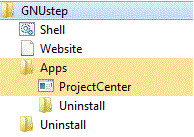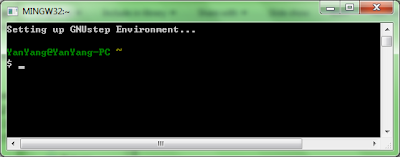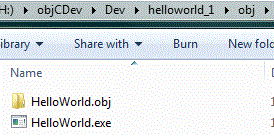In C#, or more precisely CLR .Net, developers are freed from manually allocating and freeing the memory for managed objects. But for unmanaged resources, developers must dispose them explicitly, otherwise memory leaks. In Objective-C, it's very similar to C/C++, you must and must only release objects you create.
Both languages have implemented an automatic garbage collection mechanism with two different algorithms, Reference counting by Objective-C., and Mark-sweep-compact by CLR .Net.
In Objective-C, when an object is initialized, it has a reference count of 1. when it is retained by some other object, its reference count is incremented by 1. When it receives a release message, its reference count is decremented by 1. When the reference count of an object is 0, the system treats it as garbage and deallocates the memory it occupies. Reference counting is an algorithm easy to understand. Compared with other garbage collecting algorithms, one strong point of reference counting is that it won't suspend applications from running during garbage collection. Reference count is incremented or decremented while the application is running. Developers are responsible for maintaining the reference count of objects they create by sending retain or release/autorelease messages to the objects.
But when there are cyclical references among objects, reference counting does not quite work. To work around retain cycles, Objective-C introduces weak reference. For example, x holds a strong reference to y, while y has a weak reference to x. X cannot be deallocated if any other object holds a strong reference to it. But when no object has a strong reference to x, even though y has a weak reference to x, x can be deallocated. In CLR .Net there is also a weak reference type, which I will talk about it later.
CLR implements a generational mark and compact garbage collecting mechanism. Objects are allocated in an area called the managed heap. The managed heap is different from the native C runtime heap in that it is a reserved continuous block of memory. Traditionally, objects are scattered in the native heap wherever the system can find a spot that is large enough to hold an object. The managed heap is continuous and hence it is really fast to allocate space for new objects. The managed heap is divided into 3 sections, generation 0, 1 and 2. CLR has a NextObjPtr pointer to keep track of where to put the next object. Each generation has a size limit. The size is not fixed. The garbage collector collects the statistics of your application and adjusts the size of each generation as it goes.
Now let's look at how the garbage collector works. When a method in your application gets executed, primitive types are stored in the stack. Reference types are created in Generation 0 on the managed heap. The NextObjPtr gets updated and point to the next available spot. When the method finishes execution, the stack gets cleaned up right away, but the reference types are not. The garbage collector does not deallocate reference types until Generation 0 is filled. How does it know? It could be a test against a threshold value, or the NextObjPtr points beyond Generation 0. The garbage collector will then kicks in and starts marking. It starts from the reference objects used in the current method, the so called roots, traverse to build a reference graph of all other objects referenced by the roots - they are marked as reachable objects. All non-reachable objects are treated as garbage and deallocated. Cyclical reference of objects is not an issue here. As long as these objects are not referenced by a root object, they are deemed as unreachable and will be swept. Any objects survived in the sweep are then compacted and promoted to Generation 1.
When garbage collector kicks in, all running threads are suspended so that garbage collector can analyse the managed heap and build the reference graph. When objects are compacted and moved, all pointers to these moved objects are updated to point to the new addresses by the garbage collector.
Once the garbage collection completes, the application resumes running. New objects are allocated in Generation 0. When Generation 0 is filled, garbage collector starts again. Will it clean up Generation 1? It all depends on if Generation 1 is filled or not. If not, garbage collector will not examine Generation 1. The fact may be that the objects stored in Generation 1 are not used any more and are truly rubbish, but garbage collector will leave them in memory unless Generation 1 is running out. The garbage collector will then work on Generation 1. Objects survived the collection in Generation 1 are compacted and promoted to Generation 2. Again, the garbage collector only cleans up Generation 2 when Generation 2 is filled. Survived objects in Generation 2 just stay in Generation 2. The idea of generational garbage collecting is to improve performance because examing all generations each time is expensive. The garbage collector may not compact objects each run. If the gap in memory is small, it will not compact to save the effort of moving objects around and updating the references to these objects.
So we can see some of the ideas behind the garbage collecting mechanism in CLR .Net:
1. The newer the object the shorter its life cycle might be.
2. The older the object the longer it tends to stay.
3. The more continuous the available space in the heap, the faster to allocate new objects.
4. The fewer generations to examine, the faster the garbage collecting runs.
Similar to Objective-C, .Net has a WeakReference type. E.g. these types can be referenced by other objects but that does not prevent them from being deallocated by the garbage collector. The WeakReference type may be used in a caching mechanism. But since garbage collection is not deterministic and may be more frequent than one would expect, it may not be a good way of implementing caching.
In summary, Objective-C encourages developers to leave as few memory prints as they could. While the desinger of CLR .Net believes memory management is not an easy task and therefore should be taken over by the system - performance can be sacrificed for the sake of safety.
Wednesday 1 June 2011
Sunday 10 April 2011
Programming objective-C/Cocoa frameworks on Windows 1 - Install GNUStep and Hello World
I have started exploring the possibility of programming objective-c with Cocoa frameworks on Windows over the weekend.
Objective-C is a super set of C. All native C code can be compiled down by an objective-c compiler. If I only want to play with objective-C the programming language without the Cocoa frameworks provided by Apple, a standard gcc compiler is enough.
To program in objective-C and play with the Cocoa frameworks on my Windows 7, I need to install GNUStep for Windows. GNUStep not only provides an objective-C compiler but also a robust implementation of the foundation, AppKit, and UIKit libraries in the Cocoa frameworks. Developers can program with Cocoa frameworks on many platforms using GNUStep. It is a good tool to give the apple a bite.
To get started, download the GNUStep windows installers and install them in the following order:

Click Shell and a MinGW window starts:

I can't wait to say "Hello world!".
Start NotePad++, create a Helloworld.m file.
#import <foundation foundation.h>
int main (void)
{
Create a GNUMake file in the same directory.
include $(GNUSTEP_MAKEFILES)/common.make
TOOL_NAME = HelloWorld
HelloWorld_OBJC_FILES = helloworld.m
include $(GNUSTEP_MAKEFILES)/tool.make
From the shell window, navigate to my source file folder and type "make". My first application is built.

After the "make" commad, a sub folder "obj" has been created with the following items:

To run the Helloworld.exe, in the shell window, type "obj/Helloworld" and you'll see the "Hello world!" greeting in the shell window.
The above is not a very exciting example. How about changing the code and play with AppKit a bit:
#import <foundation foundation.h>
#import <appkit.h>
int main (void)
{
The GNUMake file will also need to be modified:
include $(GNUSTEP_MAKEFILES)/common.make
APP_NAME = HelloWorld
HelloWorld_OBJC_FILES = helloworld.m
include $(GNUSTEP_MAKEFILES)/application.make
In the shell window, type "make clean" to cleanup the previous make, then "make".
To run the application, type "OpenApp Helloworld", and a message box will pop up:

Now I have a development environment and a running application - good progress!
Objective-C is a super set of C. All native C code can be compiled down by an objective-c compiler. If I only want to play with objective-C the programming language without the Cocoa frameworks provided by Apple, a standard gcc compiler is enough.
To program in objective-C and play with the Cocoa frameworks on my Windows 7, I need to install GNUStep for Windows. GNUStep not only provides an objective-C compiler but also a robust implementation of the foundation, AppKit, and UIKit libraries in the Cocoa frameworks. Developers can program with Cocoa frameworks on many platforms using GNUStep. It is a good tool to give the apple a bite.
To get started, download the GNUStep windows installers and install them in the following order:
- gnustep-msys-system-0.22.1-setup.exe
- gnustep-core-0.22.0-setup.exe
- gnustep-devel-1.0.0-setup.exe
- ProjectCenter-0.5.0-setup.exe

Click Shell and a MinGW window starts:

I can't wait to say "Hello world!".
Start NotePad++, create a Helloworld.m file.
#import <foundation foundation.h>
int main (void)
{
NSLog(@"Hello world!");
return 0;
}Create a GNUMake file in the same directory.
include $(GNUSTEP_MAKEFILES)/common.make
TOOL_NAME = HelloWorld
HelloWorld_OBJC_FILES = helloworld.m
include $(GNUSTEP_MAKEFILES)/tool.make

After the "make" commad, a sub folder "obj" has been created with the following items:

To run the Helloworld.exe, in the shell window, type "obj/Helloworld" and you'll see the "Hello world!" greeting in the shell window.
The above is not a very exciting example. How about changing the code and play with AppKit a bit:
#import <foundation foundation.h>
#import <appkit.h>
int main (void)
{
NSAutoreleasePool *pool = [NSAutoreleasePool new];
[NSApplication sharedApplication];
NSRunAlertPanel (@"Test", @"Hello world!", nil, nil, nil); [pool drain]; return 0;
}The GNUMake file will also need to be modified:
include $(GNUSTEP_MAKEFILES)/common.make
APP_NAME = HelloWorld
HelloWorld_OBJC_FILES = helloworld.m
include $(GNUSTEP_MAKEFILES)/application.make
In the shell window, type "make clean" to cleanup the previous make, then "make".
To run the application, type "OpenApp Helloworld", and a message box will pop up:

Now I have a development environment and a running application - good progress!
Thursday 31 March 2011
Quotes to share among software developers
I have been migrating a functionality from VB6 to .Net code. Tasks like this can be tricky. Normally, the original developer is no longer around left behind him/her a piece of code with no documentation about the business rules - they are hidden gems to be discovered.
I started reading the code. Anyway, the code is the best documentation a developer can have. The frustrating bit is that the main method printed out to be 5 double sided A4 pages. FIVE double sided pages of code for a single method! Every time I see code like this, I want to cry it out - could you mighty developer have some sympathy towards those who end up maintaining your great piece of work? Could you at least cut it into shorter methods with meaningful names (function names and variable names)?
Quotes like the following should be shared among developers. Something I'd love to remind myself from time to time so that people who picks up my work later won't want to kill me. I admit that sometimes I couldn't understand my own code in couple of months time, but I promise that I won't write a single method lasts for pages and pages ;).
Always code as if the person who ends up maintaining your code will be a violent psychopath who knows where you live.
-- [source]
... nearly everybody is convinced that every style but their own is ugly and unreadable. Leave out the "but their own" and they're probably right...
--Jerry Coffin (on indentation) [source]
If you need more than 3 levels of indentation, you're screwed anyway, and should fix your program.
--Linux 1.3.53 CodingStyle documentation [ source]
It's OK to figure out murder mysteries, but you shouldn't need to figure out code. You should be able to read it.
--Steve McConnell [ source]
If the code and the comments disagree, then both are probably wrong.
--attributed to Norm Schryer [source]
If you have a procedure with ten parameters, you probably missed some.
--[source]
Why do we never have time to do it right, but always have time to do it over?
--Anonymous [ source]
Computers are high-speed idiots, programmed by low-speed idiots
-- [source]
I started reading the code. Anyway, the code is the best documentation a developer can have. The frustrating bit is that the main method printed out to be 5 double sided A4 pages. FIVE double sided pages of code for a single method! Every time I see code like this, I want to cry it out - could you mighty developer have some sympathy towards those who end up maintaining your great piece of work? Could you at least cut it into shorter methods with meaningful names (function names and variable names)?
Quotes like the following should be shared among developers. Something I'd love to remind myself from time to time so that people who picks up my work later won't want to kill me. I admit that sometimes I couldn't understand my own code in couple of months time, but I promise that I won't write a single method lasts for pages and pages ;).
Always code as if the person who ends up maintaining your code will be a violent psychopath who knows where you live.
-- [source]
... nearly everybody is convinced that every style but their own is ugly and unreadable. Leave out the "but their own" and they're probably right...
--Jerry Coffin (on indentation) [source]
If you need more than 3 levels of indentation, you're screwed anyway, and should fix your program.
--Linux 1.3.53 CodingStyle documentation [ source]
It's OK to figure out murder mysteries, but you shouldn't need to figure out code. You should be able to read it.
--Steve McConnell [ source]
If the code and the comments disagree, then both are probably wrong.
--attributed to Norm Schryer [source]
If you have a procedure with ten parameters, you probably missed some.
--[source]
Why do we never have time to do it right, but always have time to do it over?
--Anonymous [ source]
Computers are high-speed idiots, programmed by low-speed idiots
-- [source]
Wednesday 16 March 2011
How to move a borderless window
I had to display a warning message sitting on top of all other windows. I created a borderless form and pinvoked a windows API function in my C# code to achieve this.
However, I found that I couldn't move the borderless window using the mouse. The border actually responds to all resize and position messages. To move a borderless window, the following is needed.
Two API methods:
[DllImport("user32.dll")]
public static extern bool ReleaseCapture();
[DllImport("user32.dll")]
public static extern IntPtr SendMessage(IntPtr hWnd, int msg, int wParam, int lParam);
Handle the mouse down event in the borderless window:
private const int WM_NCLBUTTONDOWN = 0xA1;
private const int HT_CAPTION = 0x2;
private void borderlessWindow_MouseDown(object sender, MouseEventArgs e)
{
if (e.Button == MouseButtons.Left)
{
ReleaseCapture();
SendMessage(this.Handle, WM_NCLBUTTONDOWN, (IntPtr)HT_CAPTION, IntPtr.Zero);
}
}
However, I found that I couldn't move the borderless window using the mouse. The border actually responds to all resize and position messages. To move a borderless window, the following is needed.
Two API methods:
[DllImport("user32.dll")]
public static extern bool ReleaseCapture();
[DllImport("user32.dll")]
public static extern IntPtr SendMessage(IntPtr hWnd, int msg, int wParam, int lParam);
Handle the mouse down event in the borderless window:
private const int WM_NCLBUTTONDOWN = 0xA1;
private const int HT_CAPTION = 0x2;
private void borderlessWindow_MouseDown(object sender, MouseEventArgs e)
{
if (e.Button == MouseButtons.Left)
{
ReleaseCapture();
SendMessage(this.Handle, WM_NCLBUTTONDOWN, (IntPtr)HT_CAPTION, IntPtr.Zero);
}
}
Saturday 12 March 2011
SQL Error Severity and Level Cheat Sheet
Sometimes I have to raise errors manually inside a stored procedure. It will be handy to have an error severity cheat sheet.
| Code | Description |
| 1 - 9 | Informational messages/warnings. |
| 10 | N/A. @@ERROR won't be set. |
| 11 - 16 | Regular programming errors. Level 16 is not more serious than 11 |
| 11 | Specified Database Object Not Found |
| 12 | Unused |
| 13 | User Transaction Syntax Error. E.g. deadlock. |
| 14 | Insufficient Permission |
| 15 | Syntax Error in SQL Statements |
| 16 | Miscellaneous User Error |
| 17 | Run out of a configurable resource, such as locks |
| 18 | Nonfatal internal software problems |
| 19 | Nonconfigurable resource limit has been exceeded |
| 20 | An error with a statement issued by the current process |
| 21 | SQL Server has encountered a problem that affects all the processes in a database |
| 22 | A table or index has been damaged |
| 23 | The integrity of the entire database is affected and the database will be marked suspect |
| 24 | Hardware problem |
| 25 | System error |
Subscribe to:
Posts (Atom)